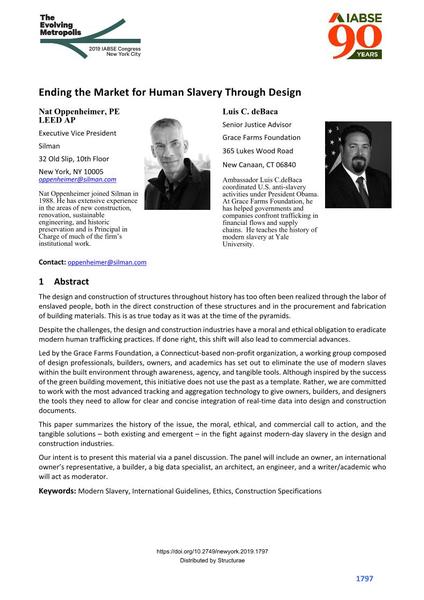Ending the Market for Human Slavery Through Design

|
|
|||||||||||
Détails bibliographiques
| Auteur(s): |
Nat Oppenheimer
(Silman)
Luis C. deBaca (Grace Farms Foundation) |
||||
|---|---|---|---|---|---|
| Médium: | papier de conférence | ||||
| Langue(s): | anglais | ||||
| Conférence: | IABSE Congress: The Evolving Metropolis, New York, NY, USA, 4-6 September 2019 | ||||
| Publié dans: | The Evolving Metropolis | ||||
|
|||||
| Page(s): | 1797-1801 | ||||
| Nombre total de pages (du PDF): | 5 | ||||
| DOI: | 10.2749/newyork.2019.1797 | ||||
| Abstrait: |
The design and construction of structures throughout history has too often been realized through the labor of enslaved people, both in the direct construction of these structures and in the procurement and fabrication of building materials. This is as true today as it was at the time of the pyramids. Despite the challenges, the design and construction industries have a moral and ethical obligation to eradicate modern human trafficking practices. If done right, this shift will also lead to commercial advances. Led by the Grace Farms Foundation, a Connecticut-based non-profit organization, a working group composed of design professionals, builders, owners, and academics has set out to eliminate the use of modern slaves within the built environment through awareness, agency, and tangible tools. Although inspired by the success of the green building movement, this initiative does not use the past as a template. Rather, we are committed to work with the most advanced tracking and aggregation technology to give owners, builders, and designers the tools they need to allow for clear and concise integration of real-time data into design and construction documents. This paper summarizes the history of the issue, the moral, ethical, and commercial call to action, and the tangible solutions – both existing and emergent – in the fight against modern-day slavery in the design and construction industries. Our intent is to present this material via a panel discussion. The panel will include an owner, an international owner’s representative, a builder, a big data specialist, an architect, an engineer, and a writer/academic who will act as moderator. |
||||
